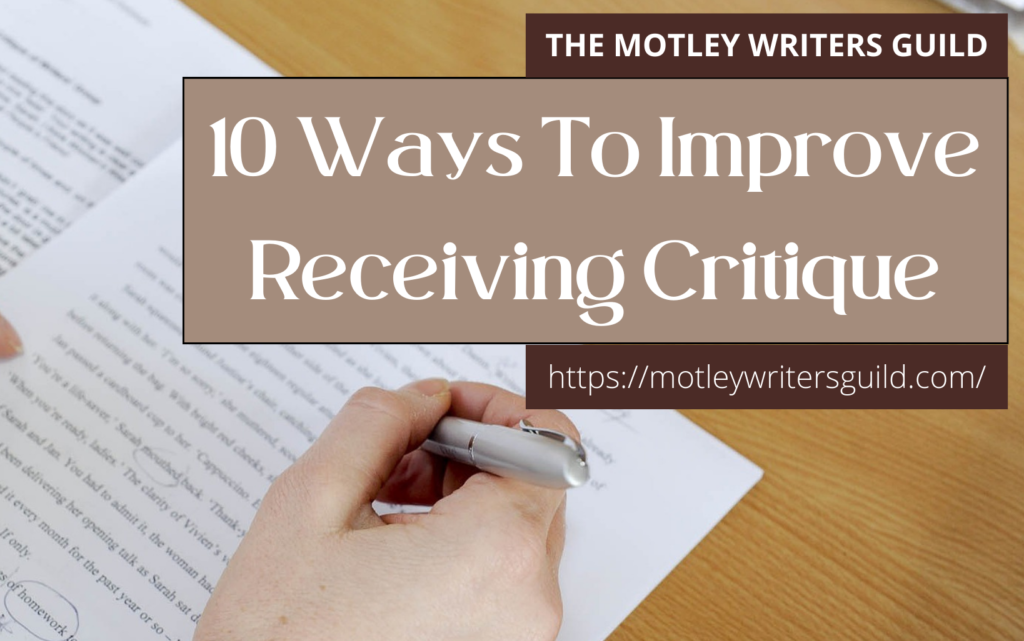
If you read my post in May – 10 Ways To Improve Your Writing Critique – You know I mentioned writing another blog about receiving critique. If you’ve been waiting with bated breath for that post to arrive, have I got a pleasant surprise for you – It’s here!
You may breathe deeply once again!
In this blog, I’ll cover my steps for requesting, reviewing, processing, and responding to solicited feedback in a way that won’t send beta readers running for the hills.
As I mentioned in my last post, you’ll likely receive a variety of different feedback on your work. Everyone processes the world around them (your writing included!) through their own lens.
This can be overwhelming as you try to sort through what critique you should incorporate into your writing and what should be considered, but ultimately won’t contribute to the story you’re trying to tell.
Below, you’ll find the steps I take when I sit down to read critique on my work. I hope this post will help you with the terrifying process of receiving feedback on your precious creation. And in a way that doesn’t end with you sending nasty emails cursing their family, their future and even their poor sweet doggo.
Remember, the people who read your work are spending their own time to give you critique that could make the difference between a good story and a great one.
Consider this practice for working with an Editor or Agent. They’ll most likely have lots of feedback for you to consider and they’ll expect you do so without cursing at them.
Step 1 – Find readers

You’ve completed your manuscript, read it over, crossed your t’s and dotted your i’s. Now what?
It’s time to find someone else to read your masterpiece!
But wait, you’re probably thinking, that’s the scary part! You’re right, it is scary. Putting your work out there to be consumed by someone else is terrifying. But ultimately, it’s necessary.
So who should you ask to help determine if your work is landing the way you want it to? Well, that depends on the feedback you want. If you just want to hear that you did a great job and deserve a gold star, pick the person who thinks you can do no wrong – your mom, your dog or your significant other.
If you want meaningful critique that will help shape the way you write long into the future, I suggest you look elsewhere. Ask other writers that you know. Ask people who read the books you want to write.
If you’re feeling very brave, try asking people who don’t read your exact genre. You might not find their feedback as applicable as someone who eats, sleeps, and breathes your genre, but you won’t get to pick who buys your book when it’s on display at the bookstore, so you might as well hear it now.
I will forever be grateful for my time with SFU’s The Writer’s Studio creative writing program. I had the privilege of working with a great group of writers from a variety of genres, and receiving critique that has transformed my writing in the best way. Every genre has benchmarks you’ll want to stick to, but that doesn’t mean you can’t learn from other genres, or even incorporate their structure into your own story.
If you’re looking for more advice on finding the right people to read your work, I’d like to once again suggest you checkout Em Van Moore’s post on How To Find Your Writing Buddies. It has some great tips for finding the right people to critique your work.
Step 2 – Describe the writing critique you want

You’ve rounded up your band of worthy heroes, now you need to assign them a quest!
Hopefully, you spent some time figuring out what type of feedback you need before you started looking for readers, as that should define the people you pick. At this step, with your readers eagerly awaiting direction, it is important to communicate to each person exactly what you’re hoping they’ll give you.
Is it more of a copy edit you’re looking for? Are you hoping to find out how the romance between the main characters is landing? Do you want to know if the story unfolds too slowly?
There are lots of helpful questions you can ask readers to consider.
Think about the background of the person who is reading your work when you give them your questions. Yes, as mentioned in the previous step, you will want to know how everyone feels about certain aspects of your book. But you also want to find your ideal reader and see how they enjoy your work. How does it compare to other books in your genre? Would they put it down at any point if they picked it up at a bookstore?
You know what you want from your readers, now how should you tell them? You have a few options.
Option 1: Include it in the email when you send your manuscript.
It is always good to include some direction in the main email either way. Let the reader know where your questions are, if you have any guidelines for them to follow, things to ignore, and when you’re hoping to hear from them.
Option 2: Include it in the manuscript, at the top of the document, before your story begins.
Some people want to give readers their questions right away, so they can consider them during their initial read. By putting them in the manuscript itself, you’re making it easier for the reader to find and add comments while they’re reading.
Option 3: Include it at the end of your manuscript.
This is my favorite option. I always put a note in my email explaining that I’ve left the questions at the end of my manuscript, hoping that a reader will look through my work first without reading them. This way they’re not biased or influenced by the way I’ve written my questions, and can react to them naturally based on their experience reading through the text.
Step 3 – Upon receipt, thank readers

This may seem like an obvious step, but it’s the when that I feel is important.
Don’t wait until you’ve reviewed the critique to thank the reader. It might seem more natural to look at their feedback first so you can thank them while adding specifics, but trust me on this one, don’t do it.
The moment you check your email (or mail if you’re old school!) and see the reviewed document, respond to them with heartfelt thanks for their time and hard work. Yes, you can quickly pop open the document to ensure they’ve sent you the right one, with lots of red markings. But DON’T, I repeat DO NOT, read any of their comments before you thank them. This is your precious work of art and you’re going to have your back up when you look at what they’ve written.
Do they even get me??
Just send a simple, but meaningful thank you and let them know you’ll take time to look through their comments and get in touch if you have questions. That way. you can buy yourself time to cool down before talking to them again.
You’re going to need it.
Step 4 – Determine how much critique you can take

Ask any writer and they’ll probably have the same response. Getting critique isn’t easy. You’ve poured your heart and soul into your work and then put it out there into the world for people to see. Scary.
The most important thing to consider when you’ve received feedback and you’re ready to sit down and look through it is, am I in the right headspace?
Am I angry? Am I tired? Am I hungry?
This doesn’t just apply to reading critique, it applies to writing critique as well. When you want to read feedback, or give it, make sure you’re in a good headspace. Don’t do it if you’re in pain, or discomfort, or distracted by something that is bothering you.
Here is what happens to me every time I read feedback someone has given me:
First, when I am in a good headspace, I sit down to read the critique. Before I even open the document, I am usually nervous. It’s worse if it’s someone giving me feedback for the first time.
What will they say? What if they hated it? What if they hated it but they’re too polite to say so?
Immediately, and without fail, I’m in defense mode.
I worked hard on this. I like it. I think I did a good job.
No matter how many compliments they’ve thrown in, I’m going to focus in on anything that isn’t 100% positive and I’m going to consider it them tearing my work apart.
Is that what really happened? Of course not. What they’ve probably done is point out parts they really like, and parts they got hung up on. It’s likely exactly what I’ve asked for, but I’m never ready to see it. Not right away, at least.
All that to say, prepare yourself to feel not so nice when you first read someone’s feedback. It’s natural. This is why so many people will tell you to read the feedback first and then put it away for a while before reading it again. I am one of those people.
The more comfortable you are with someone, the easier it gets. You’ll know when you open their critique that it’s coming from a place of love and respect. If you have multiple responses you want to read in one sitting, start with one from someone you know if you can. It’s like getting your feet wet before diving in.
If you’re receiving feedback for the first time from all your readers, consider only reading one in a sitting.
Step 5 – Find a quiet place to review the critique

You know what a great way to get in a good headspace and stay that way is? Going somewhere relaxing.
They say that one of the best ways to train a dog to get comfortable with things it’s afraid of is to feed the dog before introducing the negative stimuli. Apparently, the chemicals in a dog’s brain that are being released while it is consuming food help to combat any negative emotion from other experiences.
I’m not saying that just going to the beach will make it easy to read feedback on your work, but I truly believe there are some similar principles at play. Our brains release lots of lovely dopamine and serotonin just by being in nature.
One article on Environmental Psychology says:
The impact of time spent in nature on psychological health has traditionally been related to the concepts of attention restoration and stress recovery. However, recently it has been found to benefit multiple other aspects related to psychological, mental and social health, at the cognitive, affective and behavioral level, respectively.
Frontiers in Psychology: The Benefits of Nature-Based Solutions to Psychological Health
What better way to face an experience that is bound to cause some level of stress than by putting yourself in an environment to lower it? That won’t mean the same thing for everyone. For some it might be a blanket on the side of a grassy hill at the park, for others it is a heavy blanket draped over their lap as they curl up on the couch.
Find what works for you.
Step 6 – Read the feedback without taking notes

This step is hard. Possibly the hardest.
Just like how I encourage my readers to look through my entire manuscript before reading my questions and documenting their feedback, I will also read through someone’s critique before I make notes for myself.
If it’s too tempting to leave comments, or open a word document on your computer, try reading it first on your phone.
The reason this step is so important is because of what I said in Step 4. You may have found the most calming location in the world and sat down with good intentions, in the right headspace to receive whatever critique your readers throw at you…and you’re still probably going to get frustrated.
For myself, a lot of this frustration stems from my inability to explain myself. Many people may find they’re cool as a cucumber when reading feedback, but jump too quickly to change something identified as confusing. That’s another reason I’m advising you to not take notes during this step – you might change something now, only to find out that all of your other readers loved it.
Your first pass should just be an overview, a sampling. It gets your feet wet and gives you a taste for what might not be working in your story.
It is also when you build up your protective wall that will slowly crumble after you’ve given the critique a few days to sink in.
Open your feedback document, look through it once, or twice if you need to, and then close it and move on to Step 7.
Step 7 – Put away the critique for at least 24hrs

By this point, you should have looked at, at least one person’s feedback. You may have looked at several, the same rule still applies. Wait. Do whatever you need to do to force yourself to not look at the feedback again for at least 24 hours.
How do you know if you’re ready to look at the feedback again? I don’t think there is an exact rule on this. Most people find just “sleeping on it” is enough to break down the defensive barrier they built when they first looked at the critique.
Check in with yourself. Ask yourself what is the worst thing that could happen by considering some changes that your readers have suggested. And remember, ultimately, the power to make edits is in your hands.
I don’t recommend tossing everything your readers have to say into a proverbial dumpster and lighting it on fire, but it’s important to remember that not all their edits will work for you. We’ll cover how to determine what you should change in Step 10.
For now, take a break. Go for a walk. Get a stiff drink or a strong cup of tea.
Sleep on it.
Step 8 – Vent as needed – But NOT AT your readers

My favorite way to speed up the breaking down of my defense barrier? A good rant.
In case it wasn’t clear in the title for this step, I never, ever, EVER, rant to the person giving me feedback. I find someone I trust, preferably someone who doesn’t know the reader. Then I whine about how the reader didn’t get what I was trying to say. I use the phrase “they tore my manuscript to shreds” at least twice.
Bonus points if you can find a writer that can commiserate on the experience, or someone who will sympathize without telling you you’re overreacting.
Of course you’re overreacting! That’s what this step is all about!
How much of what I will say in this rant is factually accurate? Probably 2%, at best. That’s not the point. The point is that it is cathartic. You’ve taken on a lot of stress, probably some anxiety and a fair bit of frustration, and now you need to release it. This is why you DO NOT direct it at your reader. You likely don’t mean most of it, and you’ll regret roasting someone who was willing to take the time to review your work.
Find your person, or your pet, or your notebook (that no one will ever see), and rant to your heart’s content!
You’ll feel better.
And then you’ll start realizing that maybe it wasn’t the worst thing ever for your reader to suggest that you provide a little more sensory detail to ground them in a scene. Actually, it seems like a pretty good idea. After all, you want readers to be invested in the story.
Step 9 – After 24+hrs return to the feedback

Once you’ve cooled your head and thought about the critique you’ve received, it’s time to crack it back open again.
You’ll probably be surprised to find that words that seemed so harsh the first time you read them seem more like thoughtful suggestions now. When you know what to expect, it’s easier not to have your back up.
Now it’s time to grab that notebook and start jotting things down as they come to you. After reading several readers’ feedback, did you notice any similarities or striking differences? Were there things that someone struggled with, but someone else loved?
In the next step, we’ll determine how to decide what critique you should implement and what might change the story in a way that doesn’t match your vision. But for now, we want to get an idea of the things that do or don’t work for your readers.
This is also the perfect time to follow up with everyone who has given you feedback. Thank them again now that you’ve had the time to read through their notes. You might have initially felt hostile towards them, but chances are now you realize how much of their time they dedicated to helping you.
Mention some specific things that you liked, or found helpful about the critique and ask them any follow-up questions you can think of.
For Example: Thank you again for reading through my manuscript. I really appreciate the time you spent helping me. I hadn’t even considered that MainCharacter1’s motive might not be clear in the meadow scene. Do you think having her brother show up could make it more obvious to the reader?
Even if you don’t end up making a suggested change, it’s very helpful to understand why something did or didn’t work for a reader, even if only one person commented on it. Things are crystal clear inside our head, as we know the story back to front, sideways, upside down, and crisscross. If it isn’t clear to a reviewer, it might not be clear to any reader without the background knowledge that lives in your head.
Step 10 – Assess how/if to implement the critique

This is the last step I take after receiving a critique of my writing! It’s usually at this point that I realize how useful the process was.
I’ve probably started thinking about my story from a new angle. I have a glimpse into how the public might receive my work and some suggestions from the people I trusted to help me, for ways that might improve my story.
Now it’s time to figure out how to implement the changes.
If I was thorough in the previous step, I should have rooted out the cause of any problems that came up. Did everyone think my main character was boring and find themselves uninterested in her plight? I seriously hope not, but if they did, now is when I need to figure out what changes I could make to fix that.
It might feel overwhelming to know how to fix the problems that were addressed in the previous steps.
Start small.
You don’t have to change anything – assuming it isn’t an Editor or Agent requesting it. In that case, you’re probably going to need to be flexible. But if it’s solicited feedback from a beta reader, the power is in your hands.
I like to first go through and find the easiest things to change. Were there times it wasn’t clear who was speaking? Add some dialog tags. Did I use the same word five times in two consecutive sentences? Change some of them. Making small edits feels like you’re improving the story already, losing nothing that made it what you envisioned.
Once I’ve tweaked any small things, I save a new copy of the document. This will act as a base I can return to if I make suggested changes that don’t end up sitting right with me. From there, I can make bigger changes.
Did a reviewer suggest I try having one character enter a scene sooner? What would that look like? It can be immensely beneficial to experiment with things that a reader has suggested, even if you like the way you originally wrote it.
Worst-case scenario? You can always go back to your base copy if the edits change the desired flow too much.
Best-case scenario? You end up with a scene that unfolds more seamlessly, or a new angle to consider writing from in the future.
Think of it like trying on a bunch of outfits before going on a date. Yes, you probably looked good in the first one, but it isn’t until you try on ten more than you can really get a feel for the full potential of your look.
What about changes you don’t want to make?
You don’t have to make them. You need to consider what is at stake if you don’t, however.
Was it something that was only suggested by one reader and is more of their personal choice than a flaw in the manuscript? You can probably skip that.
Was it something suggested by most or all of your readers that could make the difference between someone putting your book down in confusion, or continuing on to find out what happens? That should warrant some consideration.
Even then, you don’t have to change it in the specific way that was suggested. If plot, motivation, or direction confuses readers, you can go back to the drawing board to figure out how to clarify those things in your own way if making the specifically suggested changes doesn’t work for you.
If character is your issue, I suggest you checkout Eileen Cook’s, Build Better Characters: The psychology of backstory & how to use it in your writing to hook readers. Eileen is a multi-published, award-winning author, and instructor, with a background in psychology that she uses to create realistic characters with relatable problems.
If you’re looking for more books on writing craft to help take your story to the next level, I suggest you checkout A.J. Hanson’s most recent blog post Top Five Books on Writing Craft.
And those are my 10 steps that I work through when I receive writing critique. Will they work for everyone? Unlikely! But I hope you’re able to consider my advice the next time you’re sitting down to request, review, process, and respond to critique you’ve received.
If you have another tip for ways to deal with receiving feedback on your precious writing, or an idea for something else you think I should blog about, let me know in the comments!
The Motley Writers Guild’s – Julie Lynn Lorewood
If you enjoyed this post, please subscribe for notifications of new blog posts from The Motley Writers Guild.



